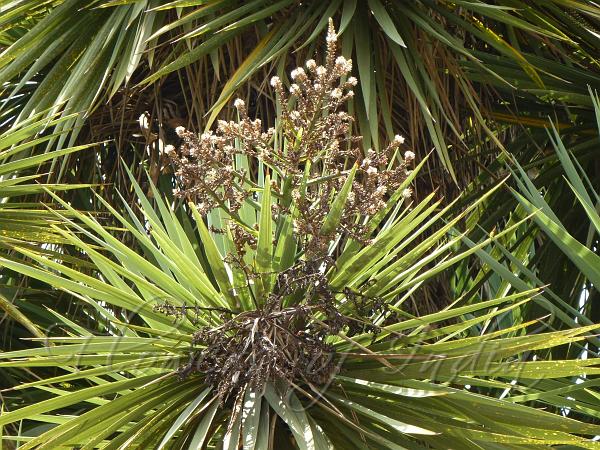|
| Cabbage Tree |
|

|

| File size | 1267650 |
| Original date | 5/23/12 1:12 PM |
| Resolution | 2560 x 1920 |
| Flash | Flash did not fire, auto |
| Focal length | 44.5mm |
| Exposure time | 1/100s |
| Aperture | 5.6 |
| Focus Distance | |
| Metering Mode | Multi-segment |
| Camera make | Panasonic |
| Camera model | DMC-TZ20 |
| Sensor type | OneChipColorArea |
|
|
|
|
Photo: |
Botanical name: Cordyline australis Family: Asparagaceae (Asparagus family)
Synonyms: Cordyline forsteri, Cordyline superbiens, Cordyline sturmii
Synonyms: Cordyline forsteri, Cordyline superbiens, Cordyline sturmii
Cabbage tree grows up to 20 m tall with a stout
trunk 1.5-2 m in diameter. Before it flowers, it has a slender
unbranched stem. After the first flowering, it divides to form a
much-branched crown with tufts of leaves at the tips of the branches.
Each branch may fork after producing a flowering stem. The pale to dark
grey bark is corky, persistent and fissured, and feels spongy to the
touch. The long narrow leaves are sword-shaped, erect, dark to light
green, 0.5-3 ft long and 3-7 cm wide at the base, with numerous
parallel veins. The leaves grow in crowded clusters at the ends of the
branches, and may droop slightly at the tips and bend down from the
bases when old. They are thick and have an indistinct midrib. The fine
nerves are more or less equal and parallel. The upper and lower leaf
surfaces are similar. In spring and early summer, sweetly perfumed
flowers are produced in large, dense flower spikes 2-3 ft long, bearing
well-spaced to somewhat crowded, almost stalkless flowers and axes. The
flowers are crowded along the ultimate branches of the panicles. The
bracts which protect the developing flowers often have a distinct pink
tinge before the flowers open. The individual flowers are 5-6 mm in
diameter, the tepals are free almost to the base, and reflexed. The
stamens are about the same length as the tepals. The fruit is a white
berry 2-3 inches in diameter which is eaten by birds. The nectar
attracts great numbers of insects to the flower.
| Identification credit: Tabish | Photographed in Botanical Gardens, Ooty. |